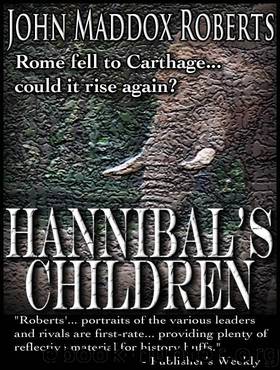Hannibal's Children by John Maddox Roberts

Author:John Maddox Roberts [Roberts, John Maddox]
Language: eng
Format: azw3, epub
Tags: Science Fiction, Action & Adventure, Fiction
ISBN: 9780441010387
Google: 7zEJAAAACAAJ
Amazon: B004H4XRB4
Publisher: Ace Books
Published: 2003-02-14T18:30:00+00:00
They entered the great harbor of Alexandria from the west on a glorious morning so windless that the smoke from the great lighthouse towered straight up like an offering ascending to the gods. The lighthouse itself was at the eastern tip of the island of Pharos, but even from the western end it bulked huge, standing a full four hundred feet high, ornate with marble columns in every Greek style. It was built in four stepped-back sections, the terraces green with lush plantings that hung over the railings, bedizened with dazzling flowers.
"A lighthouse makes sense," said Brutus. "But why tart it up with all that decoration?"
"It's a matter of aesthetics, Brutus," Flaccus informed him. "You wouldn't understand."
The western harbor was called the Eunostos, the harbor of "happy return." Within, it proved to be even greater than the harbor at Carthage. As if the lighthouse were not wonder enough, the island was connected with the mainland by a causeway called the Heptastadion, because it was seven stadia in length. The causeway was raised and pierced with arches so that ships could sail beneath it to the smaller Palace Harbor on the eastern side.
Lining the shore they could see broad plazas, gigantic warehouses, statues of gods and kings, ships without number from all parts of the world. Their skipper pointed out some of the wonders of the city. The vast temple that hulked a half-mile inland in the eastern part of the city was the Serapion, temple of Serapis, patron god of Alexandria. The strange, conical hill near the center of the metropolis was the Paneum, an artificial mound planted with the flora of Thessaly and topped with a circular shrine to the goat-footed nature god. Beyond the Heptastadion lay the sprawling palace and museum complexes. The whole city was built of white stone and it shone in the morning light like a philosopher's dream of a city, not a real city where men and women lived out their lives.
They did not moor in the Eunostos but rowed beneath one of the arches pierced through the causeway into the Palace Harbor. Here there were few commercial vessels but many warships, royal galleys and pleasure barges of stunning size and luxuriance. In the harbor was a small island with its own miniature palace, a marvel of perfect proportions.
Marcus noted that, while Alexandria lacked the architectural chaos of Carthage, its predominantly Greek design had an Egyptian overlay. While the buildings were almost exclusively Greek, some were ornamented with Egyptian hieroglyphics and the statues of gods and kings, while Greek in execution, were often arranged in traditional Egyptian poses; stiffly seated or striding, wearing items of Egyptian dress or bearing the attributes of Egyptian gods.
Drakon steered a course toward the structure that dominated the waterfront: a palace wing built on the scale favored by the Successor kings. It looked like a place where giants would live. The Ionic columns were at least fifty feet in height, the pediment they supported featuring a battle between gods and titans, the figures twice human height.
Download
This site does not store any files on its server. We only index and link to content provided by other sites. Please contact the content providers to delete copyright contents if any and email us, we'll remove relevant links or contents immediately.
Sita - Warrior of Mithila (Book 2 of the Ram Chandra Series) by Amish(54651)
The Crystal Crypt by Dick Philip K(36771)
Cat's cradle by Kurt Vonnegut(15184)
Always and Forever, Lara Jean by Jenny Han(14799)
Ready Player One by Cline Ernest(14524)
The Last by Hanna Jameson(10146)
Year One by Nora Roberts(9700)
Persepolis Rising by James S. A. Corey(9225)
The remains of the day by Kazuo Ishiguro(8820)
Never let me go by Kazuo Ishiguro(8704)
Red Rising by Pierce Brown(8608)
Dark Space: The Second Trilogy (Books 4-6) (Dark Space Trilogies Book 2) by Jasper T. Scott(8116)
The handmaid's tale by Margaret Atwood(7679)
The Circle by Dave Eggers(7035)
Frank Herbert's Dune Saga Collection: Books 1 - 6 by Frank Herbert(6937)
The Testaments by Margaret Atwood(6773)
Legacy by Ellery Kane(6583)
Pandemic (The Extinction Files Book 1) by A.G. Riddle(6458)
Six Wakes by Mur Lafferty(6151)
